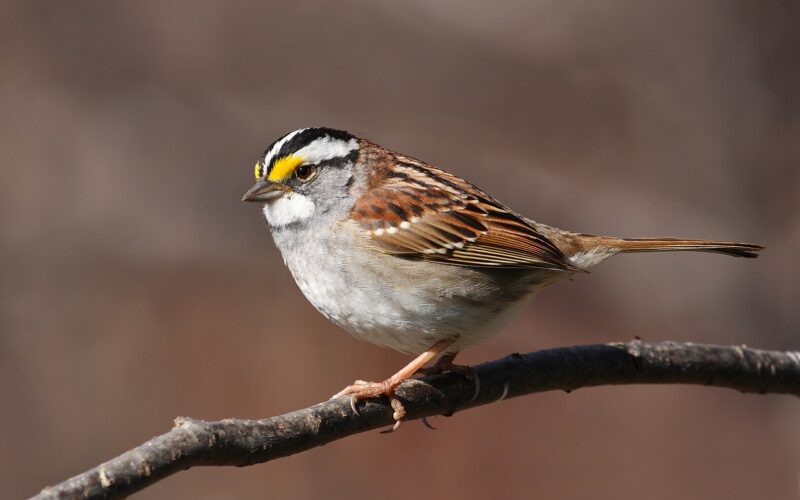Last Updated on January 20, 2024 by Greg Gillson
Many people start feeding birds in winter. But they often don’t know exactly the best way to start.
Do you need ideas for the best bird feeders and the best bird seed and foods to feed birds?
Would you like a brief guide to the most likely birds at your feeder in winter?
This article is for you!
This article tells why and how to set up a bird feeder in Kentucky in the winter. I’ll also show you photos of the common feeder birds in Kentucky that you can look for at your own backyard feeder! I will give brief identification tips. I will tell you what foods and what type of feeders attract each species.
Why feed winter birds in Kentucky?
Winters in Kentucky are cold, with 15 to 20 inches of snowfall during the season. The north and east part of the state is colder. Snow on the ground may last 2 weeks there. In the south and west snow generally only stays on the ground a week, at most.
Most birds in winter can survive on their own without bird feeders. However, birds are attracted to the easier food finding opportunities at feeders.
This means that birds will readily come to your feeders. If you set up a feeder you should have lots of birds.
And that brings us to the main reason to feed birds. It’s fun!
Feeding birds brings wildlife into your yard. It connects us with nature. It is especially important during those cold dreary days of winter. We often don’t get outside as much as when the weather is warmer. So, a bird feeder can allow us to view nature out our window!
A splash of color. A flurry of activity. Birds brighten our day.
Other people in your neighborhood likely feed birds as well. Drive down the street and see. This activity gives you a shared interest with your neighbors. It may lead to lasting friendships. And it’s better than talking about the weather!

What birds come to feeders in winter in Kentucky?
Some birds at your feeder in winter may be birds that spend the summer in northern areas. These “winter visitors” may arrive as early as October to their wintering grounds. Many often stay in southern areas until April, before migrating north to find a place to breed and raise their young.
Many of the birds at your feeder in winter are year-round residents. They don’t migrate. They live in your neighborhood and will visit your feeders all year long.
You may notice that some of these year-round residents visit less often in summer, when there is a lot of natural food–seeds and insects–for them to eat. But they’ll gradually visit more and more often as autumn progresses.
You’ll quickly learn the common birds at your feeder. Then you may notice when something unusual arrives. Part of the fun of feeding birds is that something new could show up at any time! Many people like to keep track of what birds visit. Try recording a new list of feeder visitors each month!
Here then are some of the most likely birds to visit your feeder in Kentucky during the winter.
Northern Cardinal
These are well-known birds due to their bright red coloration, fairly large size, and perky crest.
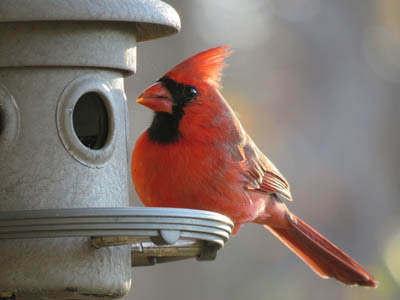 |
| Northern Cardinal. GeorgeB2 from Pixabay. |
These are year-round residents throughout the East and South.
Northern Cardinals are year-round residents throughout Kentucky.
Larger than sparrows, but smaller than robins. Males are bright red, females brown. They have thick orange bills, black chin and throat, and obvious crests.
Northern Cardinals eat larger seeds, including sunflower seeds and safflower seeds from hopper and platform feeders, but often feed on the ground.
Carolina Chickadee
This cute little bird is widespread throughout the southeastern United States in deciduous forests.
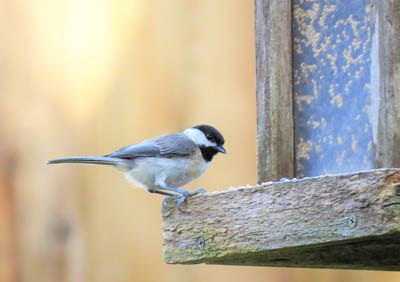 |
| Carolina Chickadee. Image by George2 from Pixabay |
Carolina Chickadees are year-round residents throughout Kentucky.
It gives a rapid chick-a-dee-dee-dee call and a whistled song fee-bee, fee-bay.
Gray back, wings, tail, and pale gray flanks. Black cap and throat contrasting with white face.
Carolina Chickadees like seeds, especially black oil sunflower seeds. They like suet, too. They eat from any kind of feeder.
Blue Jay
These are well-known birds, displayed in advertising and sports teams.
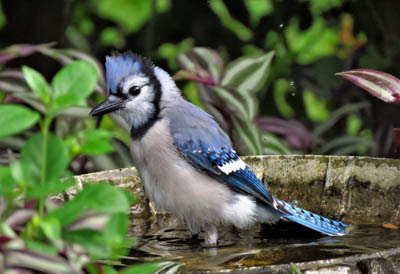 |
| Blue Jay. Skeeze from Pixabay. |
They live year-round in deciduous woods with oaks or nuts through most of the United States east of the Rocky Mountains. In summer they also migrate north well into Canada.
Blue Jays are year-round residents throughout Kentucky.
These are blue above, white below and on the face, with a black necklace across the throat wrapping behind the head. The blue crest is a distinguishing mark.
Blue Jays eat sunflower seeds. They love peanuts, too. They use hopper and platform feeders.
Mourning Dove
These birds are one of the most widespread in North America.
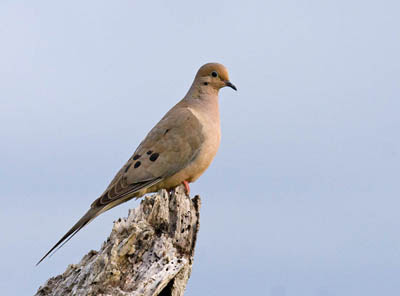 |
| Mourning Dove. Greg Gillson. |
In summer they breed in open fields, farms, prairies, towns, across all of the United States and north into Canada. In winter they depart most of Canada and the northern Great Plains and higher elevations in the northern states.
Mourning Doves are year-round residents throughout Kentucky.
These plump birds have a small round head and pointed tail. They are larger than most feeder birds, but not as large as a domestic pigeon.
Mourning Doves eat mixed seeds and grains. They prefer eating on the ground or from platform feeders.
Tufted Titmouse
These plain birds are rather common at bird feeders in the East.
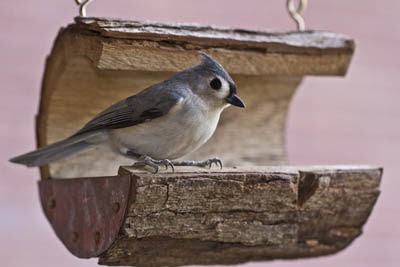 |
| Tufted Titmouse. Anne773 from Pixabay. |
These birds live year-round in deciduous woods east of the Great Plains in the United States.
Tufted Titmice are year-round residents throughout Kentucky.
Small, a bit larger than chickadees. They are plain gray with a bit of black feathers on their forehead. The crest is often inconspicuous.
Tufted Titmice eat black oil sunflower seeds from hopper feeders. They are also fond of peanuts.
Downy Woodpecker
This small woodpecker is widespread in North America and fairly common at bird feeders in winter.
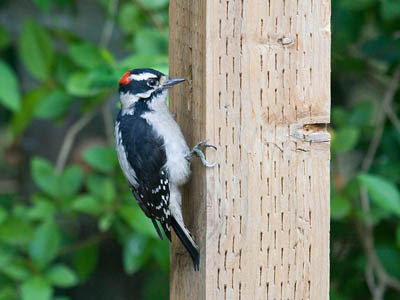 |
| Downy Woodpecker. Greg Gillson. |
Year-round residents from Alaska and across Canada south through the United States but absent from the Desert Southwest.
Downy Woodpeckers are year-round residents throughout Kentucky.
These are less than 7 inches long, bill tip to tail tip. They have a black and white striped head, white back, and black wings with white spots.
Downy Woodpeckers love suet from suet feeders. They also eat hulled sunflower seeds.
Red-bellied Woodpecker
These woodpeckers are fairly common at bird feeders in the East, especially where there are larger hardwood trees.
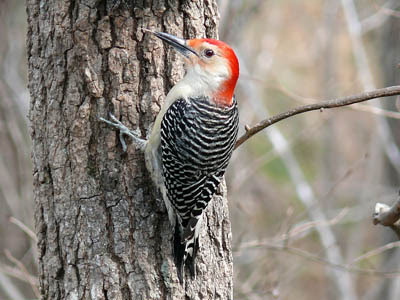 |
| Red-bellied Woodpecker. Skeeze from Pixabay. |
These birds live year-round in the United States east of the Rocky Mountains and Great Plains.
Red-bellied Woodpeckers live year-round throughout Kentucky.
These birds cling to tree trunks. They have finely barred black-and-white backs. The head and under parts are rather pale gray. Red feathers on the back of the neck reach the bill on males.
Red-bellied Woodpeckers love peanuts from platform feeders. They also eat sunflower seeds and suet.
American Goldfinch
This bright yellow-and-black bird is a favorite summer bird. However, many people don’t recognize these birds at their feeders in their dull brown winter plumage.
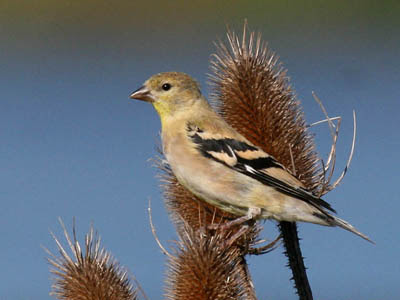 |
| American Goldfinch. Greg Gillson. |
Year-round residents across the northern half of the United States. In summer birds breed north well into Canada. In winter they move south throughout most of the U.S.
American Goldfinches are year-round residents throughout Kentucky.
These are tiny birds with short forked black tails. Wings are black. Winter birds are dull brownish. In summer females are green while males are brilliant lemon yellow with black cap.
American Goldfinches eat black oil sunflower seeds from tube feeders. They love Niger seed from thistle feeders.
Song Sparrow
This is a common wetland bird across North America that also hides out in backyards with large bushes and hedges.
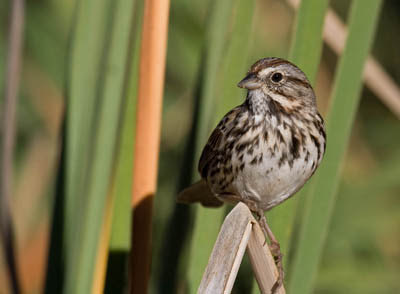 |
| Song Sparrow. Photo by Greg Gillson |
Song Sparrows are year-round residents throughout Kentucky.
It forages and hops on the ground where its heavy dark brown streaking provides camouflage in the shadows.
It has a a trilled song that starts with two burry notes and a buzz. Its call sounds like chimp.
Song Sparrows will eat mixed seeds and black oil sunflower seeds from a hopper or platform feeder.
Carolina Wren
This wren is a common resident in woodland tangles and backyards throughout the East.
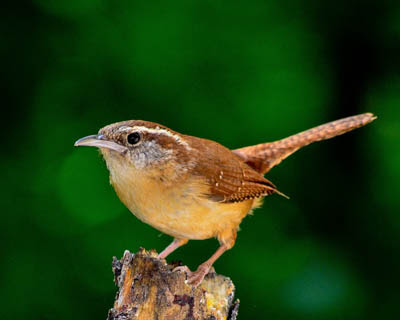 |
| Carolina Wren. SOARnet from Pixabay |
Carolina Wrens are year-round residents throughout Kentucky.
They sing all year, a loud musical teakettle, teakettle, teakettle or cheery cheery cheery. The call notes are loud and varied, including a chert call.
These have typical round wren bodies with short neck and long active tails. They are rich brown above, warm buffy below with a white throat and long white eyebrow strip back from the eye.
Carolina Wrens visit suet feeders.
Dark-eyed Junco
These “snowbirds” flock to your feeders in winter.
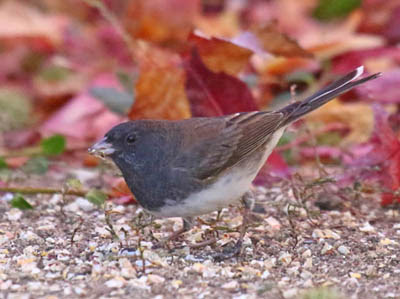 |
| Dark-eyed (Slate-colored) Junco. Greg Gillson. |
Breed in conifer and mixed woods across Canada and Alaska in summer, then migrate into most of the United States in winter. They are also resident in mountains of the West and Northeast.
Dark-eyed Juncos are winter visitors throughout Kentucky.
The form in the East are small slate-gray birds with white belly and flashing white outer tail feathers. Females are browner. In the West, birds have black heads, brown backs, and pink sides.
Dark-eyed Juncos eat small seeds such as white proso millet on the ground or from low platform feeders.
White-throated Sparrow
These birds are fairly common in the East in winter, rather rare throughout the West.
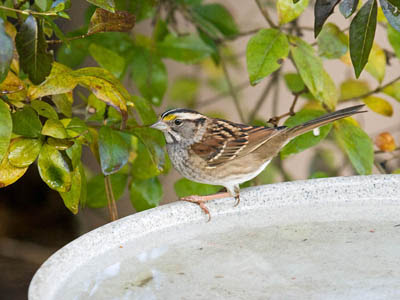 |
| White-throated Sparrow. Greg Gillson. |
These birds breed in Canada and northeastern United States. In winter they occur in the eastern and southern U.S.
White-throated Sparrows are winter throughout Kentucky.
These fairly large brown and gray sparrows have a striped head. The head striping can be gray and tan or black and white. The obvious white throat is bordered on the sides with throat stripes and contrasts strongly with the gray breast.
White-throated Sparrows eat smaller seeds such as white proso millet found in better mixed seed brands. They prefer to eat on the ground or platform feeders but will also use hopper feeders.
House Finch
These are one of the most widespread feeder birds in the United States.
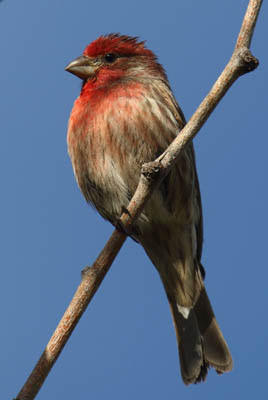 |
| House Finch. Greg Gillson. |
These birds are resident in towns throughout the United States, barely into southern Canada.
House Finches are year-round residents throughout Kentucky.
Both males and females are rather dusty brown, heavily streaked on the chest. Only the males have red feathers on forehead, breast, and rump.
House Finches love to eat black oil sunflower seeds in the shell. They like tube feeders best.
White-breasted Nuthatch
Nuthatches are active birds that crawl around branches and even head-first down tree trunks!
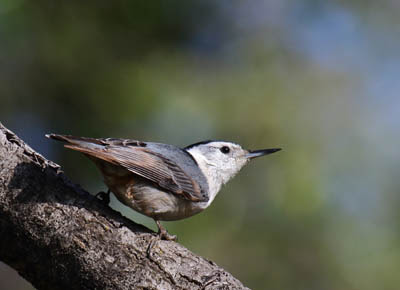 |
| White-breasted Nuthatch. Greg Gillson. |
These are widespread year-round birds across southern Canada and much of the United States. They avoid grasslands and deserts.
White-breasted Nuthatches are year-round residents throughout Kentucky.
These are small chunk birds with large heads with long pointed bill and very short tails. These are gray above with black hind neck and crown. The face and under parts are white. They have a bit of rusty coloration on the flanks.
White-breasted Nuthatches eat black oil sunflower seeds from tube and hopper feeders and are fond of peanuts and suet, too.
House Sparrow
These are common city birds in noisy messy flocks.
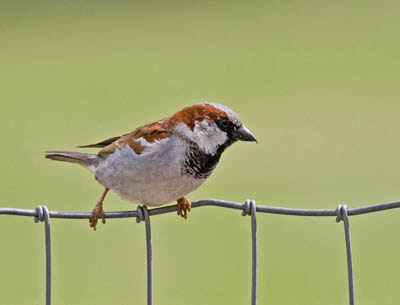 |
| House Sparrow. Greg Gillson. |
Found throughout much of Canada and the United States, wherever there are people and towns.
House Sparrows are year-round residents throughout Kentucky.
Small squatty flat-headed sparrows. Females are rather brown and tan with a pale broad eyebrow, and plain breast without streaking. Males are more chestnut brown above with white wing bars, gray below, with gray crown and black chin, more extensive in summer.
House Sparrows eat a wide variety of small seeds and human food scraps from hopper and platform feeders, and also the ground.
Setting up a winter bird feeding station in Kentucky
Now you’ve learned about the common feeder birds in Kentucky and what they eat. So now, what’s the best way to attract these exact birds to your backyard feeder?
You may have noticed that they all don’t eat the same foods. So a single bird feeder isn’t going to attract all the birds equally. Instead, you’ll want to set up a couple of feeders with foods targeted to each species.
So, first of all, I’m going to recommend black oil sunflower seeds. Most seed eating birds love this seed the best. In fact, some birds such as Blue Jays and House Sparrows gobble down sunflower seeds so fast that you may want to try to restrict them. This is done by feeding black oil sunflower seeds from a tube feeder.
A tube feeder is best for tree-feeding birds such as House Finches, American Goldfinches, Carolina Chickadees, White-breasted Nuthatches, and Tufted Titmice. At the same time, the tube feeder is a bit harder for bigger birds, and those with weaker feet, to feed from. So it makes it harder for those jays and house sparrows to take over the feeder.
Next, you want a platform or hopper feeder for ground-feeding birds such as the White-throated Sparrows, Dark-eyed Juncos, Northern Cardinals, Song Sparrows, and House Sparrows. These birds will sit in the feeder and eat, so a cheaper mixed bird seed is best. A mixture of sunflower seeds and white proso millet is best. Make sure these are your first two ingredients. Don’t buy bird seed with red milo or cracked corn as your first two ingredients or you’ll get mostly house sparrows and lots of wasted food thrown out.
For something different try a suet feeder. It has rendered fat in a cage. Birds really like this in winter. It provides nutrition for those insect-eating birds that spend the winter. Thus, this is a favorite way to get Carolina Wrens, Downy Woodpeckers, and Red-bellied Woodpeckers to your feeder. But it may attract other species that don’t eat seeds. And chickadees and nuthatches eat suet, too. If jays or starlings or blackbirds are a problem, buy an upside-down suet feeder, rather than the simple cage.
A thistle sock is a type of mesh feeder that holds tiny seeds of the Niger plant. These are favorite seeds of small finches–especially American Goldfinches and sometimes House Finches. Every few winters Pine Siskins invade southward when their northern cone crop fails. These are small like goldfinches and brown-streaked like female House Finches, with a touch of yellow in wing and tail best seen in flight.
Wrapping Up
Feeding wild birds in winter is a wonderful thing to do – both for you and the birds! Here are a few additional tips to help you get the most out of the experience:
Clean feeders regularly with hot soapy water and a disinfectant solution to prevent disease spread. Dispose of old, moldy seed to avoid attracting unwanted pests and rake up spilled seed on the ground to discourage rodents.
Avoid using pesticides or herbicides near feeders to protect birds from poisoning and keep cats indoors or supervised to prevent bird predation.
Start feeding early in the winter before natural food sources dwindle. Offer water for drinking and bathing, especially during freezing temperatures and most importantly – enjoy watching your feathered visitors and learn about their different behaviors and preferences.
By following these tips, you can create a welcoming haven for winter birds in your Kentucky backyard and experience the joy of connecting with nature right outside your window. Happy birdwatching!
Frequently Asked Questions
What birds stay in Kentucky during winter?
While many songbirds migrate south for the winter, Kentucky still boasts a vibrant avian population during the colder months. As well as those I listed above, these birds may also visit during the winter:
Red-breasted Nuthatches: Acrobatic climbers with rusty chests, they add bursts of orange to winter trees.
Common Loons: These diving birds spend the winter on Kentucky’s lakes and reservoirs.
Rough-legged Hawks: Soaring high above with broad wings, they hunt rodents in open fields.
What birds migrate in Kentucky?
Kentucky experiences a delightful turnover of avian residents throughout the year, with an amazing array of birds migrating through or changing their seasons within the state. Here’s a glimpse into the feathered comings and goings:
Spring Migrants (April-May):
- Warblers: A stunning parade of color and song arrives, including Black-and-white, Yellow, Hooded, Kentucky, and many more.
- Tanagers: Scarlet beauties like Summer Tanagers and vibrant Western Tanagers grace the forests.
- Vireos: Red-eyed, Yellow-throated, and Warbling Vireos fill the air with their complex musicality.
- Thrushes: Wood Thrushes and Hermit Thrushes return with their soulful melodies.
- Flycatchers: Eastern Wood-Pewees and Eastern Kingbirds bring their insect-catching skills north.
Summer Residents (June-August):
- Hummingbirds: Ruby-throated Hummingbirds flit around flowers, adding a touch of magic to gardens.
- Cuckoos: Yellow-billed Cuckoos lay their eggs in other birds’ nests, while Black-billed Cuckoos sing their “rain-crow” call.
- Swallows: Barn Swallows grace open fields, while Tree Swallows and Purple Martins nest in cavities.
- Wrens: Carolina Wrens and House Wrens fill bushes with their energetic songs and hops.
Fall Migrants (September-October):
- Warblers: The southbound parade starts, with different species gracing Kentucky than in spring.
- Sparrows: White-throated and Dark-eyed Juncos arrive from the north, adding winter interest.
- Raptors: Hawks, owls, and falcons migrate south, showcasing their aerial prowess.
- Waterfowl: Ducks and geese begin their journey south, adding dramatic flocks to lakes and rivers.
Related Articles:
The most common backyard birds in Kentucky
Birds at Your Feeder in Kentucky






